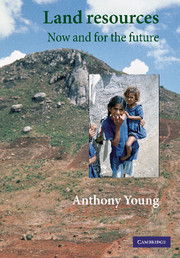Book contents
- Frontmatter
- Contents
- Preface
- Acknowledgements
- Note on acronyms and currency
- 1 Concern for land
- 2 Land resource issues
- 3 Resource survey and land evaluation
- 4 Competition for land
- 5 Working with farmers
- 6 Land use planning
- 7 Land degradation
- 8 Global issues: climatic change and biodiversity
- 9 Monitoring change: land resource indicators
- 10 Costing the earth: the economic value of land resources
- 11 Land management: caring for resources
- 12 Research and technology
- 13 Land, food, and people
- 14 Population, poverty, and conflict
- 15 Awareness, attitudes, and action
- Notes
- References
- Index
11 - Land management: caring for resources
Published online by Cambridge University Press: 04 August 2010
- Frontmatter
- Contents
- Preface
- Acknowledgements
- Note on acronyms and currency
- 1 Concern for land
- 2 Land resource issues
- 3 Resource survey and land evaluation
- 4 Competition for land
- 5 Working with farmers
- 6 Land use planning
- 7 Land degradation
- 8 Global issues: climatic change and biodiversity
- 9 Monitoring change: land resource indicators
- 10 Costing the earth: the economic value of land resources
- 11 Land management: caring for resources
- 12 Research and technology
- 13 Land, food, and people
- 14 Population, poverty, and conflict
- 15 Awareness, attitudes, and action
- Notes
- References
- Index
Summary
The older approach to land management, based on the transfer of Western technologies, has been replaced by a new set of ideas. For management of the croplands, new approaches include the land husbandry basis for soil conservation, low-input sustainable agriculture, and small-scale irrigation. On open rangelands, reconciling the extreme complexity of land management needs with communal tenure raises problems which are almost insuperable. Multiple-purpose forest management has replaced the earlier focus on wood production. Agroforestry has helped to diversify farm production, and offered new means of soil management.
These new approaches have a number of ideas in common: understanding the processes in the soil, water, and plant ecosystem, as a basis for their modification; adapting management methods to the infinite variety of local conditions; and increasing production not by taking in more land nor with higher inputs, but by using soils, water, fertilizers, and plant resources with greater efficiency. Finally, it has invariably been found that best results come from a participatory approach, implementing changes through the joint efforts of resource scientists and the knowledge and skills of the local people.
The fundamental principle of land management is sustainability, the combination of production with conservation. Given the extent of poverty, the urgency of the food situation in the developing world, and the present low level of productivity of many farming systems, the priority must be to increase production. This has to be achieved in ways that do not degrade, and where possible improve, the land resource base on which production depends.
- Type
- Chapter
- Information
- Land ResourcesNow and for the Future, pp. 179 - 202Publisher: Cambridge University PressPrint publication year: 1998



